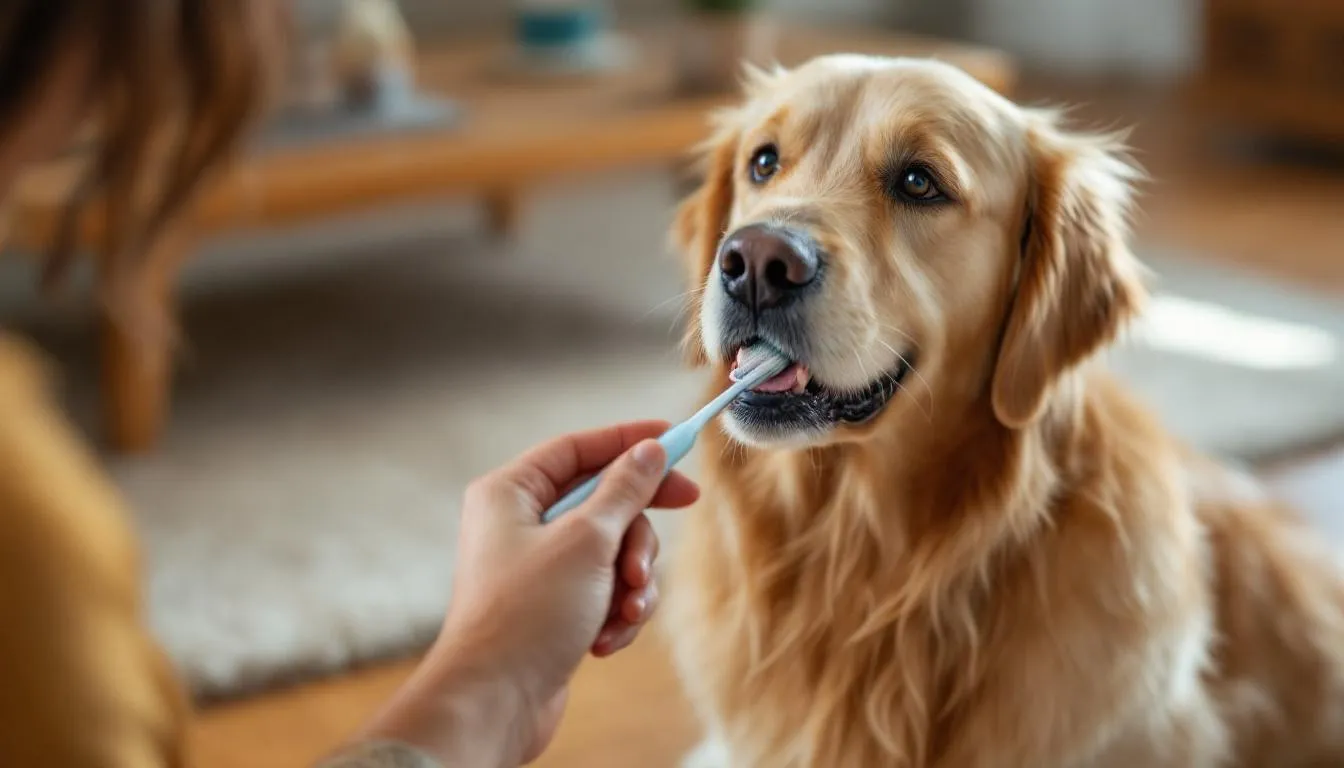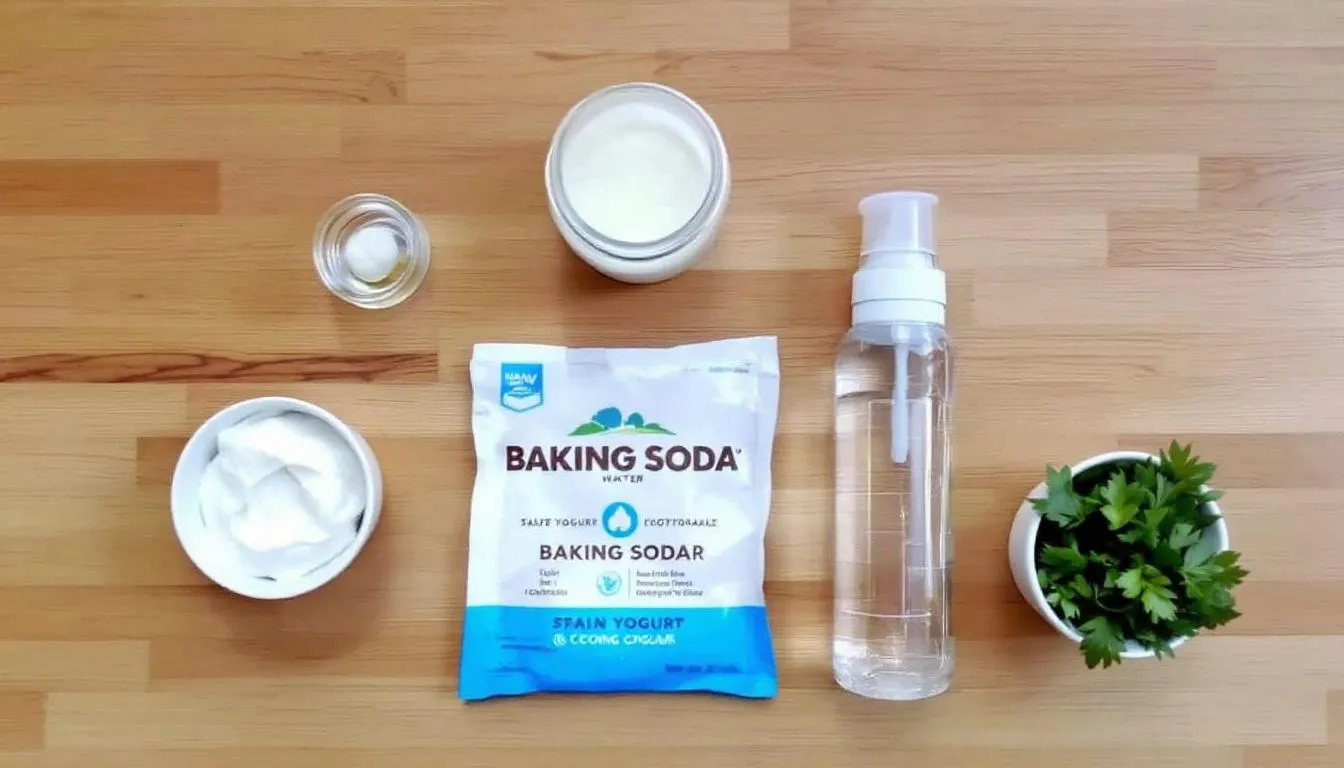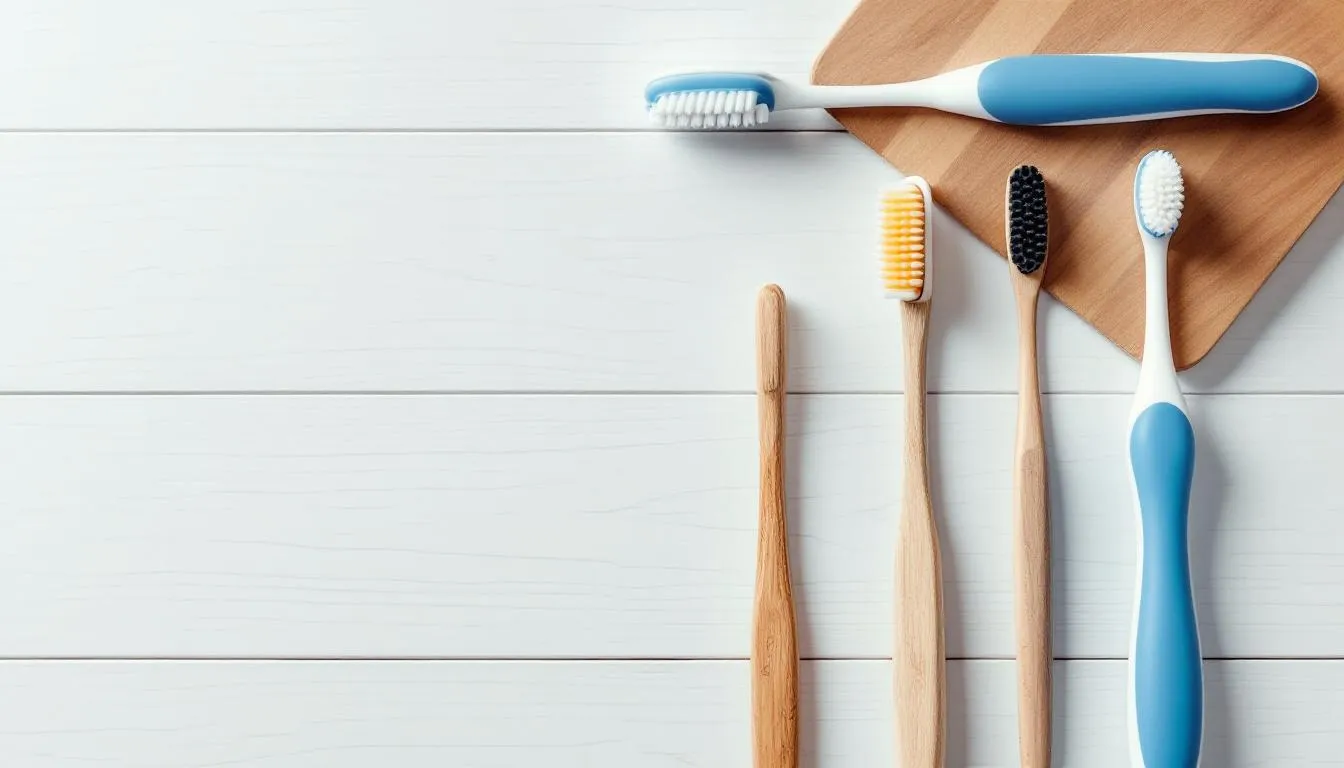Key Takeaways
- Homemade dog toothpaste using safe ingredients like coconut oil and baking soda can effectively clean your dog’s teeth and freshen breath
- Never use human toothpaste on dogs as it contains toxic ingredients like xylitol and fluoride that can be fatal
- Simple three-ingredient recipes with coconut oil, baking soda, and dog-safe flavorings work best for homemade formulations
- Baking soda should be used sparingly and only in small amounts to avoid stomach upset or enamel damage
- Regular brushing with homemade toothpaste 2-3 times per week can prevent gum disease and reduce veterinary dental costs
Homemade dog toothpaste using safe ingredients like coconut oil and baking soda can effectively clean your dog’s teeth and freshen breath
Never use human toothpaste on dogs as it contains toxic ingredients like xylitol and fluoride that can be fatal
Simple three-ingredient recipes with coconut oil, baking soda, and dog-safe flavorings work best for homemade formulations
Baking soda should be used sparingly and only in small amounts to avoid stomach upset or enamel damage
Regular brushing with homemade toothpaste 2-3 times per week can prevent gum disease and reduce veterinary dental costs
Introduction to Dog Dental Care
Dog dental care is a crucial part of your pet’s overall health routine. Just like people, dogs are prone to issues like bad breath, plaque buildup, and tartar buildup if their teeth aren’t cared for properly. Using dog toothpaste is one of the most effective ways to keep your dog’s teeth clean and their mouth healthy. With so many choices—ranging from DIY dog toothpaste and natural dog toothpaste to store bought dog toothpaste—it can be tough to know what’s best for your pup. Regular brushing not only helps prevent dental problems but also keeps your dog’s breath fresh and their teeth free from harmful plaque. In this article, we’ll break down the benefits of using dog toothpaste, the importance of consistent brushing, and how to choose the right option for your dog’s dental care needs.


Why Make Homemade Dog Toothpaste
Here’s a sobering fact: 80% of dogs develop gum disease by age three. That’s not just bad breath—it’s painful periodontal disease that can lead to tooth loss, infections, and expensive veterinary procedures. The good news? Regular brushing with the right toothpaste for dogs can prevent most of these problems.
Cost matters too. A quality store bought dog toothpaste runs $5-15 and lasts maybe a month with regular use. Your homemade version costs under $2 and works just as effectively for basic plaque removal and maintaining your dog’s oral health.
Making your own diy dog toothpaste gives you complete control over what goes into your dog’s mouth. No artificial preservatives, no mysterious chemicals, and definitely no sodium lauryl sulfate or foaming agents that serve no real purpose for dogs. Homemade toothpaste is chemical free, so you avoid artificial and chemical ingredients that could harm your pet. You choose natural ingredients that are safe if swallowed—because let’s be honest, your dog will swallow some. You can also select the active ingredients that provide cleaning and oral health benefits, such as abrasives for cleaning and enzymes to help break down plaque and tartar.
The customization factor is huge. Some dogs love the taste of coconut oil, others prefer a chicken broth flavor. You can adjust recipes based on your pup’s preferences and sensitivities, creating a personalized solution that actually gets used instead of fighting your dog every time you approach with a toothbrush.
With so many choices—ranging from DIY dog toothpaste to store-bought options with a variety of flavors and claims—it can be tough to know what’s best for your pup. That’s why it’s important to select the best dog toothpaste for safety and effectiveness, ensuring it is veterinarian-approved and formulated for your dog’s needs.
Most ingredients for natural dog toothpaste are already sitting in your kitchen. Coconut oil, baking soda, plain yogurt—these common items become powerful tools for fighting plaque buildup and keeping your dog’s breath fresh.


Essential Ingredients for Safe Homemade Dog Toothpaste
Coconut oil forms the perfect base for homemade toothpaste. It’s naturally antimicrobial thanks to lauric acid, which fights the oral bacteria that cause bad breath and dental disease. These are the active ingredients in homemade dog toothpaste, responsible for cleaning and supporting oral health. Dogs typically love the taste, making teeth cleaning sessions much easier. Making the toothpaste something your dog enjoys and likes can make the brushing process more pleasant and effective. The oil also has anti-inflammatory properties that support gum health.
Baking soda, or sodium bicarbonate, works as a gentle abrasive that removes plaque without damaging tooth enamel when used properly. Its alkaline nature creates an environment where harmful bacteria struggle to thrive. The key is moderation—too much can irritate your dog’s stomach or be too harsh on teeth.
For safe flavoring, stick to options dogs actually enjoy. Plain Greek yogurt adds probiotics that benefit oral health while creating a creamy texture. Low-sodium chicken broth powder gives a savory taste most dogs find irresistible. Bone broth works similarly and provides additional minerals.
Optional beneficial add-ins include turmeric for its anti-inflammatory effects and kelp powder for natural minerals that support dental health. A tiny amount of neem oil can boost antimicrobial action, though many dogs dislike the bitter taste. Other ingredients, such as herbs or supplements, can also be included to enhance effectiveness and flavor.
Here’s what to absolutely avoid: xylitol (deadly to dogs even in tiny amounts), fluoride (toxic when swallowed), artificial sweeteners of any kind, regular mint (can cause stomach upset), and tea tree oil (toxic to pets). Human toothpaste is completely off-limits—it contains multiple ingredients that can poison your dog. Not all toothpastes are created equal, so it's important to choose or make ones with safe, dog-friendly ingredients.
Refreshing Ingredients for Your Dog’s Breath
If you want to keep your dog’s breath fresh and their teeth clean, the right natural ingredients can make all the difference. Coconut oil is a favorite in many DIY dog toothpaste recipes because it helps fight bacteria and reduce plaque buildup, all while being tasty for your dog. Baking soda is another go-to ingredient, working to neutralize acids and freshen breath, but it should always be used in moderation. Olive oil is a gentle addition that can soothe gums and support oral health. For an extra boost, try adding turmeric for its anti-inflammatory benefits, neem oil for its natural antibacterial properties, or parsley for a burst of freshness. By choosing these natural ingredients, you can create a dog toothpaste that not only helps reduce plaque but also keeps your dog’s breath fresh and their mouth healthy.
4 Proven Homemade Dog Toothpaste Recipes
Basic Coconut Oil Recipe
This starter recipe works for most dogs and uses just two ingredients:
- 2 tablespoons melted coconut oil
- 1 tablespoon baking soda
2 tablespoons melted coconut oil
1 tablespoon baking soda
Gently warm the coconut oil until it’s soft but not hot. Gradually mix in the baking soda until you get a smooth paste. Store in an airtight container in the refrigerator for up to one week. Let it soften to room temperature before each use—cold coconut oil is too hard for comfortable brushing.
This basic version effectively removes plaque and neutralizes odors. Start here if your dog has never had their teeth brushed before.
Chicken Broth Flavored Toothpaste
For picky eaters who need extra motivation:
- 1/4 cup coconut oil
- 2 tablespoons baking soda
- 2 tablespoons plain yogurt
- 1 teaspoon low-sodium chicken bouillon powder
1/4 cup coconut oil
2 tablespoons baking soda
2 tablespoons plain yogurt
1 teaspoon low-sodium chicken bouillon powder
Dissolve the bouillon in 1 tablespoon of hot water first, then let it cool. Mix all ingredients thoroughly until smooth. This version stores in the refrigerator for up to three weeks and works especially well for dogs who prefer savory flavors over neutral ones.
The yogurt adds beneficial probiotics that support oral health, while the chicken flavor makes brushing time feel more like treat time.
Turmeric and Kelp Immune-Boosting Recipe
For dogs needing extra anti-inflammatory support:
- 2 tablespoons coconut oil
- 1 tablespoon baking soda
- 1/4 teaspoon turmeric powder
- 1/4 teaspoon kelp powder
2 tablespoons coconut oil
1 tablespoon baking soda
1/4 teaspoon turmeric powder
1/4 teaspoon kelp powder
Mix dry ingredients first to prevent clumping, then gradually work in the softened coconut oil. The turmeric provides anti-inflammatory benefits for irritated gums, while kelp adds natural minerals. Freeze individual portions in ice cube trays for convenient single-use servings.
Note: turmeric can stain, so use this recipe sparingly and rinse your dog’s mouth afterward if they have white fur around their muzzle.
Gentle Yogurt-Based Recipe
Perfect for dogs with sensitive stomachs:
- 3 tablespoons plain Greek yogurt
- 1/2 tablespoon baking soda
3 tablespoons plain Greek yogurt
1/2 tablespoon baking soda
This gentler formula cuts the baking soda content in half while adding probiotics that benefit both oral and digestive health. Use immediately or refrigerate for 3-5 days maximum. The creamy texture works well for dogs just learning to accept teeth brushing.
This recipe serves as an excellent introduction for nervous dogs or puppies over 12 weeks old.
Fresh Breath Solutions
Fresh breath is more than just a bonus—it’s a sign of good oral health for your dog. If your pup struggles with bad breath, it could be due to plaque buildup or tartar buildup on their teeth. The best way to keep your dog’s breath fresh is with regular brushing using a dog toothbrush and a safe toothpaste made for dogs. For an extra touch of freshness, you can add natural ingredients like parsley or mint leaves to your homemade toothpaste. Chew toys and dental chews are also great for helping to reduce plaque and tartar, supporting both fresh breath and strong, healthy teeth. By making teeth cleaning a regular part of your dog’s routine, you’ll help them maintain a healthy mouth and a breath you won’t mind getting close to.
Tooth Powder vs. Toothpaste: Which is Best for Your Dog?
Choosing between tooth powder and toothpaste for your dog comes down to your pet’s preferences and dental needs. Tooth powder can be a good option for dogs who dislike the texture of traditional toothpaste—it’s easy to sprinkle on their teeth and gums, making the process less stressful. However, toothpaste often provides more effective cleaning, thanks to its gentle abrasiveness that helps with removing plaque and tackling tartar buildup. Some dogs may respond better to one over the other, so it’s worth trying both to see which your dog prefers. If you’re unsure which is best for your dog’s teeth, consult your veterinarian for personalized advice. No matter which you choose, the most important thing is to keep up with regular brushing to fight plaque and keep your dog’s mouth healthy.


Safety Guidelines and Precautions
Baking soda toxicity becomes dangerous at 10-20 grams per kilogram of body weight. That’s roughly 2-4 teaspoons for a 20-pound dog—far more than any toothpaste recipe calls for. Still, watch for signs of baking soda poisoning: vomiting, diarrhea, lethargy, or excessive thirst. If you see these symptoms after brushing, contact your vet immediately.
Coconut oil is generally safe but high in calories. A small dog getting daily brushing with coconut oil-based toothpaste could consume an extra 50-100 calories per week. Dogs with pancreatitis should avoid coconut oil entirely due to its fat content.
Storage matters for safety. Homemade toothpaste lacks preservatives, so bacterial growth becomes a real concern. Oil-based recipes stay fresh for 1-2 weeks refrigerated, while yogurt-based versions last only 3-5 days. Frozen portions can last up to three months but thaw and use within 24 hours.
Consult your veterinarian before starting homemade toothpaste if your dog has existing dental disease, takes medications, or has food allergies. Some conditions require enzymatic toothpaste or prescription treatments that homemade versions can’t provide. The Veterinary Oral Health Council (VOHC) approves certain products for safety and efficacy, so look for VOHC approval when choosing toothpaste for your dog. You know exactly what goes into your dog’s mouth, which helps keep your dog's mouth free from harmful substances and bacteria.


How to Use Homemade Dog Toothpaste Effectively
Start slow. Let your dog sniff and taste a small amount of toothpaste from your finger before attempting actual brushing. Many dogs will readily lick coconut oil-based recipes, making this introduction phase easier.
Begin with finger brushing using a piece of gauze wrapped around your index finger or a finger toothbrush. Focus on the outer surfaces of teeth where plaque accumulates most. Gentle brushing helps protect your pup's teeth from plaque and tartar. The gum line and back molars need the most attention, but don’t force anything during early sessions.
Graduate to a soft-bristled dog toothbrush once your pup accepts finger brushing calmly. Human toothbrushes work fine for large dogs, but small dogs need appropriately sized brushes. Electric toothbrushes typically scare dogs unnecessarily.
Proper technique involves gentle circular motions along the gum line rather than aggressive scrubbing. Regular brushing of dog teeth helps prevent bad breath and supports overall dental health. Spend 30-60 seconds per session initially, building up to 2-3 minutes as your dog becomes comfortable. Most plaque forms on the outside of teeth, so don’t worry about getting the inner surfaces perfect.
Brush 2-3 times per week minimum, though brushing your dog's teeth daily provides the best results for optimal oral health. Morning brushing works better than evening for most dogs—they’re more alert and cooperative earlier in the day.
Training reluctant dogs requires patience and positive reinforcement. Start by just touching their muzzle and rewarding calm behavior. Gradually work up to lifting their lips, touching their teeth, and finally actual brushing. Use high-value treats immediately after each successful session.
Homemade vs Store-Bought Dog Toothpaste Comparison
|
Factor |
Homemade Dog Toothpaste |
Store Bought Dog Toothpaste |
|---|---|---|
|
6-Month Supply Cost |
$4-8 |
$25-60 |
|
Ingredient Control |
Complete |
Limited |
|
Shelf Life |
1-3 weeks |
12-24 months |
|
Flavor Customization |
Unlimited |
Pre-set options |
|
Enzymatic Action |
None |
Available in premium brands |
|
Preservatives |
None |
Usually present |
|
Effectiveness |
Good for basic care |
Varies by brand |
Factor
Homemade Dog Toothpaste
Store Bought Dog Toothpaste
6-Month Supply Cost
$4-8
$25-60
Ingredient Control
Complete
Limited
Shelf Life
1-3 weeks
12-24 months
Flavor Customization
Unlimited
Pre-set options
Enzymatic Action
None
Available in premium brands
Preservatives
None
Usually present
Effectiveness
Good for basic care
Varies by brand
Store bought toothpaste wins on convenience and shelf life. Enzymatic dog toothpaste contains specialized enzymes that break down plaque more effectively than mechanical brushing alone. These products cost more but provide superior cleaning action for dogs with significant tartar buildup.
Homemade versions excel at ingredient purity and cost effectiveness. You know exactly what goes into your dog’s mouth, and you can adjust recipes for specific sensitivities or preferences. Controlling the ingredients in homemade dog toothpaste allows you to choose options like cinnamon or herbs, which may offer additional health benefits and support your pet’s overall well-being. For basic preventive care in healthy mouths, homemade toothpaste performs comparably to most commercial options.
The best toothpaste is the one your dog will tolerate consistently. A store bought option your dog loves beats a homemade recipe they fight every time.
Signs Your Dog’s Dental Health is Improving
Fresh breath appears within 1-2 weeks of regular brushing with quality toothpaste. This is a sign of improved dog's oral health. While dog breath will never smell minty fresh, it should lose that sharp, unpleasant odor that signals bacterial overgrowth in the mouth. Addressing your dog's breath with regular dental care can help eliminate common causes of bad breath and support overall oral hygiene.
Visual improvements take longer but are more dramatic. Yellow tartar buildup on teeth gradually diminishes with consistent brushing. The process is slow—expect to see changes over 4-6 weeks rather than days.
Gum health improves faster than you might expect. Inflamed, red gums return to a healthy pink color within 2-3 weeks of regular oral hygiene. Bleeding during brushing sessions decreases as gums toughen and heal.
Your dog’s eating habits may improve as oral discomfort decreases. Dogs with painful gums often eat more slowly or avoid hard kibble. As dental health improves, they typically return to normal eating patterns and may show renewed interest in chew toys.
Professional cleanings become less frequent when home care is consistent. Veterinarians often extend the time between dental procedures for dogs receiving regular at-home dental care.


Signs Your Dog’s Dental Health is Improving
Within the first week or two of consistent brushing with your homemade doggie toothpaste, you’ll notice your dog’s breath becoming noticeably fresher. That sharp, unpleasant smell that signals bacterial overgrowth starts to fade as you establish better oral hygiene habits.
The visual changes take a bit longer but are worth the wait. After 4-6 weeks of regular brushing, you’ll see the yellow tartar build up on your dog’s teeth gradually diminishing. This isn’t an overnight transformation—think of it as a gentle, steady improvement that protects your pup’s teeth from more serious dental disease.
Gum health improves faster than many pet parents expect. Those red, inflamed gums that might bleed during early brushing sessions typically return to a healthy pink within 2-3 weeks of consistent care. Less bleeding during brushings is always a good sign that your dog’s oral health is heading in the right direction.
Watch for improvements in eating habits too. Dogs suffering from oral discomfort often eat more slowly or avoid harder foods entirely. As their mouths feel better, they usually return to normal eating patterns and may even show renewed interest in chew toys they’d been avoiding.
Your veterinary visits become more pleasant when your vet notices the improvement. Many dogs with consistent home dental care can extend the time between professional cleanings, saving both money and stress for everyone involved.
FAQ
Is it safe to use baking soda in homemade dog toothpaste daily?
Small amounts used in toothpaste recipes are safe, but limit brushing to 2-3 times per week to prevent enamel damage and stomach upset from regular ingestion. Daily use of baking soda can be too abrasive for your dog’s teeth over time.
Can I substitute olive oil for coconut oil in recipes?
Yes, olive oil works as an alternative base for your diy toothpaste, though coconut oil provides additional antimicrobial benefits and most dogs prefer the taste. Olive oil lacks the natural antibacterial properties that make coconut oil particularly effective for oral health.
How long does homemade dog toothpaste last?
Oil-based recipes last 1-2 weeks refrigerated in an airtight container, yogurt-based recipes only 3-5 days, and frozen portions can last up to 3 months. Always check for changes in smell, texture, or color before use.
What should I do if my dog refuses homemade toothpaste?
Try different flavors like bone broth or xylitol-free peanut butter, start with just finger massage to build tolerance, or consider enzymatic store bought alternatives. Some dogs need weeks to accept teeth cleaning, so patience and positive reinforcement are key.
Can puppies use homemade dog toothpaste?
Puppies over 12 weeks can use homemade toothpaste, but use half the baking soda amount and focus on gentle gum massage during teething periods. Their puppy teeth are more sensitive, so start with the yogurt-based recipe and very gentle pressure during cleaning sessions.
FAQ
Is it safe to use baking soda in homemade dog toothpaste daily?
Small amounts used in toothpaste recipes are safe, but limit brushing to 2-3 times per week to prevent enamel damage and stomach upset from regular ingestion. Daily use of baking soda can be too abrasive for your dog’s teeth over time.
Can I substitute olive oil for coconut oil in recipes?
Yes, olive oil works as an alternative base for your diy toothpaste, though coconut oil provides additional antimicrobial benefits and most dogs prefer the taste. Olive oil lacks the natural antibacterial properties that make coconut oil particularly effective for oral health.
How long does homemade dog toothpaste last?
Oil-based recipes last 1-2 weeks refrigerated in an airtight container, yogurt-based recipes only 3-5 days, and frozen portions can last up to 3 months. Always check for changes in smell, texture, or color before use.
What should I do if my dog refuses homemade toothpaste?
Try different flavors like bone broth or xylitol-free peanut butter, start with just finger massage to build tolerance, or consider enzymatic store bought alternatives. Some dogs need weeks to accept teeth cleaning, so patience and positive reinforcement are key.
Can puppies use homemade dog toothpaste?
Puppies over 12 weeks can use homemade toothpaste, but use half the baking soda amount and focus on gentle gum massage during teething periods. Their puppy teeth are more sensitive, so start with the yogurt-based recipe and very gentle pressure during cleaning sessions.






